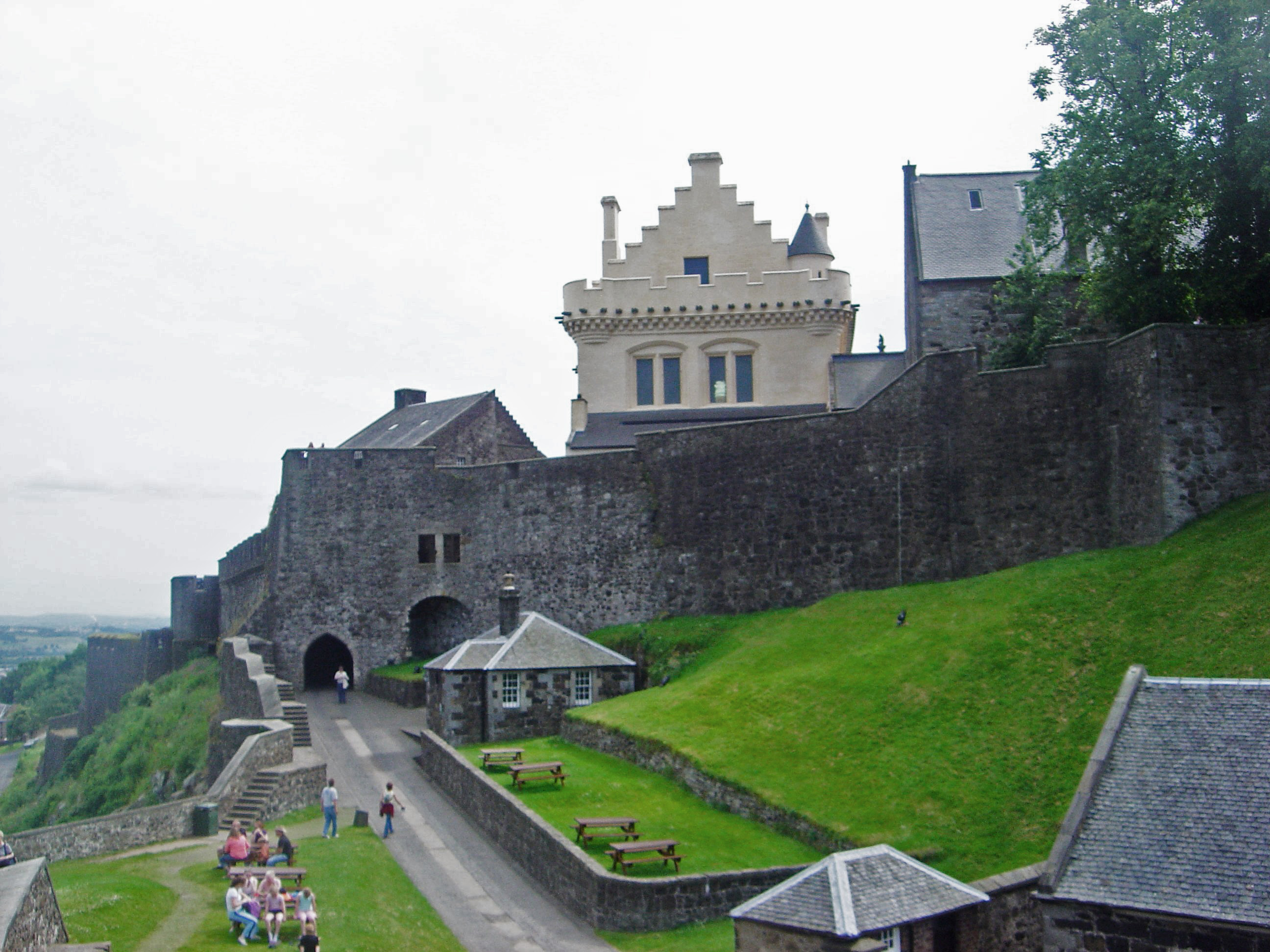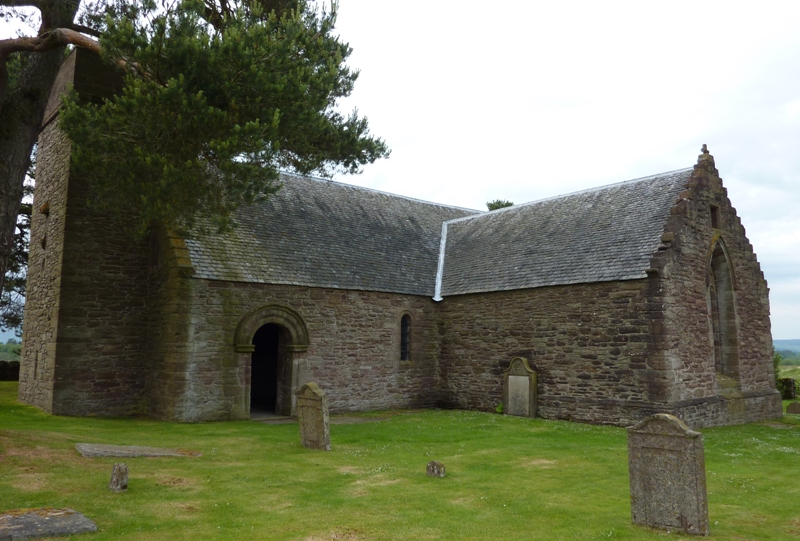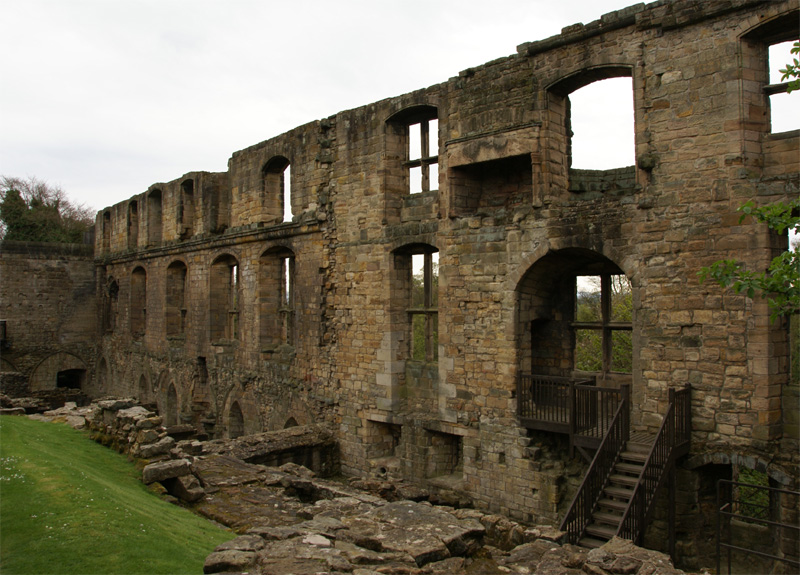|
James Redheuch
James Redheuch, Redeheuch, Reidheugh, Riddoch, or Reddoch (died 1541) was a Scottish courtier. He was a burgess of Stirling and became a steward in the household of James IV of Scotland when he was prince (before the death of James III of Scotland. As Comptroller of Scotland from 1505 to 1509 and 1512 to 1513, and Chamberlain of Menteith and of Strathearn, Redheuch was in charge of revenues paid to James IV of Scotland. He was also a steward of the household from 1502 to 1510. Redheuch usually acted as an administrator the king's household, while Duncan Forestar of Garden was the equivalent comptroller of Margaret Tudor's household. In November 1503 he bought pewter water pots for the royal household. In October 1504, he organised carts to come to Dunfermline Palace to help evacuate Margaret Tudor and her English servants to Lindores Abbey because of a plague scare. The carts were not used, and Margaret and the " More Lassis" came to Edinburgh in November. Redheuch held variou ... [...More Info...] [...Related Items...] OR: [Wikipedia] [Google] [Baidu] |
James IV Of Scotland
James IV (17 March 1473 – 9 September 1513) was List of Scottish monarchs, King of Scotland from 11 June 1488 until his death at the Battle of Flodden in 1513. He inherited the throne at the age of fifteen on the death of his father, James III of Scotland, James III, at the Battle of Sauchieburn, following a rebellion in which the younger James was the figurehead of the rebels. James IV is generally regarded as the most successful of the House of Stuart, Stewart monarchs of Scotland. He was responsible for a major expansion of the Royal Scots Navy, Scottish royal navy, which included the founding of two royal dockyards and the acquisition or construction of 38 ships, including the ''Great Michael'', the largest warship of its time. James was a patron of the arts and took an active interest in the law, literature and science. With his patronage the Chepman and Myllar Press, printing press came to Kingdom of Scotland, Scotland, the University of Aberdeen and the Royal College o ... [...More Info...] [...Related Items...] OR: [Wikipedia] [Google] [Baidu] |
Lindores Abbey
Lindores Abbey was a Tironensian abbey on the outskirts of Newburgh in Fife, Scotland. Now a reduced ruin, it lies on the southern banks of the River Tay, about north of the village of Lindores and is a scheduled monument. The abbey was founded as a daughter house of Kelso Abbey in 1191 (some sources say 1178), by David, Earl of Huntingdon, on land granted to him by his brother William the Lion. The first abbot was Guido, Prior of Kelso, under whom the buildings were mostly completed. The church, dedicated to the Blessed Virgin and St. Andrew, was long, with transepts long. Edward I of England, John Balliol, David II, and James III were among the monarchs who visited Lindores at different times. The Abbey ceased operation in 1559. History David Stewart, Duke of Rothesay, who died during imprisonment at Falkland Palace in 1402, was buried at the Abbey. The abbey was sacked by a mob from Dundee in 1543, and again by John Knox and his supporters in 1559. Accordi ... [...More Info...] [...Related Items...] OR: [Wikipedia] [Google] [Baidu] |
Comptrollers Of Scotland
A comptroller (pronounced either the same as ''controller'' or as ) is a management-level position responsible for supervising the quality of accounting and financial reporting of an organization. A financial comptroller is a senior-level executive who acts as the head of accounting, and oversees the preparation of financial reports, such as balance sheets and income statements. In most Commonwealth countries, the comptroller general, auditor general, or comptroller and auditor general is the external auditor of the budget execution of the government and of government-owned companies. Typically, the independent institution headed by the comptroller general is a member of the International Organization of Supreme Audit Institutions. In American government, the comptroller is effectively the chief financial officer of a public body. In business management, the comptroller is closer to a chief audit executive, holding a senior role in internal audit functions. Generally, the title ... [...More Info...] [...Related Items...] OR: [Wikipedia] [Google] [Baidu] |
Jane Dawson
Jane Elizabeth Anne Dawson is a British academic and historian. Her specialism is early modern history within the British Isles and the Protestant reformation. Dawson is Professor Emerita of Reformation history at the University of Edinburgh and has previously served as a lecturer and honorary lecturer in modern history at the University of St Andrews. Career Dawson completed her BA and PhD in History at the University of Durham. In 1977 she became the first Glenfiddich Fellow in Scottish History at the University of St Andrews. In 1979 Dawson began a postgraduate teaching qualification at the University of Dundee and Dundee College for Education. Following this, Dawson took on a temporary post as teacher of history at Bell Baxter High School in Cupar, Fife. In 1982, Dawson entered a number of tutoring and lecturing positions within Scottish and Modern History within the University of St Andrews and from 1990 to 1992 held the position of honorary lecturer. She remai ... [...More Info...] [...Related Items...] OR: [Wikipedia] [Google] [Baidu] |
Tullibardine
Tullibardine is a location in Perth and Kinross, Scotland, which gives its name to a village, a castle and a grant of nobility. The village of Tullibardine is a settlement of approximately forty dwellings about southwest of Perth. It lies in the parish of Blackford, and the nearest town is Auchterarder, to the south. Tullibardine Castle was a medieval fortification on a low eminence west of the village. Little is known about it and it no longer exists. The castle was built by the Clan Murray in the late 13th to early 14th century, after it had extended its holdings south from its heartland in Morayshire. The castle predates the nearby chapel, which is dated to 1446. The castle was dismantled in 1747, following the Jacobite rebellion, and was completely demolished in 1833. Tullibardine Chapel was built in the 1446 by David Murray of Tullibardine as a family chapel and burial site, and members of the Murray family were buried there until 1900. The chapel has remained unaltered ... [...More Info...] [...Related Items...] OR: [Wikipedia] [Google] [Baidu] |
Tullibardine Castle
Tullibardine Castle was a castle located in the village of Tullibardine, north of Auchterarder in Perth and Kinross, Scotland. History The lands of Tullibardine passed to the Murray family after Ada de Strathearn, the wife of William Murray, was granted the other moiety of Tullibardine from her aunty. The castle was built in the late 13th to early 14th century, with likely its first custodian being David Murray, Baron of Tullibardine.''Sharpe's Peerage of the British Empire exhibiting its present state and deducing the existing descents from the ancient nobility of England, Scotland and Ireland'', Volume 1, John Sharpe (1830) One early Murray owner of the castle was said to have had seventeen sons. The king thought he had broken the law by having an armed retinue. The brothers were said to have slept in a large round room in the castle, their heads placed against a central pillar. The outline of the ship, the ''Great Michael'', commissioned by James IV, was commemorated by ... [...More Info...] [...Related Items...] OR: [Wikipedia] [Google] [Baidu] |
William Murray (died 1562)
William Murray of Tullibardine (1510–1562) was a Scottish landowner. Family background He was a son of William Murray (died 1513), William Murray and Margaret Stewart. His mother was a daughter of John Stewart, 1st Earl of Atholl, and Eleanor Sinclair. His father rebuilt Tullibardine Chapel and sent hart horns from Tullibardine to Edinburgh for the costumes of "wild men" at the tournament of the Wild Knight and the Black Lady. He was killed at the battle of Flodden in 1513. Career William Murray inherited the main family residence at Tullibardine Castle, in the village of Tullibardine, north of Auchterarder, Perth and Kinross, from his grandfather (also William Murray) in 1525. During the war with England known as the Rough Wooing, William Murray and his wife Katherine Campbell communicated with Thomas Wharton, 1st Baron Wharton, Thomas Wharton at Carlisle. He was an opponent of the party of David Beaton, Cardinal Beaton in Scotland and became a member of the Lennox faction ... [...More Info...] [...Related Items...] OR: [Wikipedia] [Google] [Baidu] |
Comrie, Perth And Kinross
Comrie (; ; Pictish: ''Aberlednock''; Roman Empire, Latin: ''Victoria'') is a village and parish in the southern Scottish Highlands, Highlands of Scotland, towards the western end of the Strathearn district of Perth and Kinross, west of Crieff. Comrie is a historic conservation village in a National Scenic Area (Scotland), national scenic area along the river Earn. Its position on the Highland Boundary Fault explains why it has more earth tremors than anywhere else in Britain. The parish is twinned with Carleton Place, Ontario, Canada. Location and etymology Comrie lies within the registration county of Perthshire (Gaelic: ''Siorrachd Pheairt'') and the Perth and Kinross local council area. The name Comrie derives from the original Gaelic name ''con-ruith'' or ''comh-ruith'' (from ''con/comh'' 'together', and ''ruith'' "to run", "running") translating literally as "running together", but more accurately as "flowing together" or "the place where rivers meet". In modern Gaelic th ... [...More Info...] [...Related Items...] OR: [Wikipedia] [Google] [Baidu] |
Cultybraggan Camp
Cultybraggan Camp, also known as the Black Camp of the North, is a former prisoner of war (PoW) camp located close to the village of Comrie, in west Perthshire, Scotland. Built in 1941, it was one of two high-security PoW camps in Britain during World War II and held many prisoners classified by British authorities as the most committed Nazis. The camp became notorious following the murder of ''Feldwebel'' Wolfgang Rosterg at the hands of other prisoners, with five later executed at Pentonville prison for their role in his death. During the Cold War, Cultybraggan housed a Royal Observer Corps monitoring post and an underground Regional Government Headquarters bunker. The site has since been sold under a community right-to-buy scheme to the Comrie Development Trust, who have overseen the conversion of some of the camp's Nissen huts into accommodation and locations for business ventures. Historic Scotland considers Cultybraggan to be "one of the three best preserved purpose- ... [...More Info...] [...Related Items...] OR: [Wikipedia] [Google] [Baidu] |
Ellen More
Ellen or Elen More () was an African servant ( Kammermohr) at the Scottish royal court. She probably arrived in Scotland in the company of a Portuguese man with imported animals. There are records of clothing and gifts given to her, although her roles and status are unclear. Some recent scholarship suggests she was enslaved, and her arrival in Scotland can be linked indirectly with the slave trade. She is associated with a racist poem by William Dunbar, and may have performed in Edinburgh as the "Black Lady" at royal tournaments in 1507 and 1508. Background Ellen More was employed in Edinburgh Castle in the household of Lady Margaret, the daughter of James IV of Scotland and his mistress Margaret Drummond. Ellen More and Margaret More were later attendants of Margaret Tudor at Linlithgow Palace. She was first mentioned by name, "Elen More", in the royal accounts in December 1511. Possibly remaining in the household of the young James V, she was last mentioned in the accounts ... [...More Info...] [...Related Items...] OR: [Wikipedia] [Google] [Baidu] |
Margaret Tudor
Margaret Tudor (28 November 1489 – 18 October 1541) was List of Scottish royal consorts, Queen of Scotland from 1503 until 1513 by marriage to King James IV. She then served as regent of Scotland during her son's minority, and fought to extend her regency. Margaret was the eldest daughter and second child of King Henry VII of England and Elizabeth of York, and the elder sister of King Henry VIII of England. By her line, the House of Stuart eventually acceded to the throne of Kingdom of England, England and Kingdom of Ireland, Ireland, in addition to Kingdom of Scotland, Scotland. Margaret married James IV at the age of 13, in accordance with the Treaty of Perpetual Peace between England and Scotland. Together, they had six children, though only one of them reached adulthood. Margaret's marriage to James linked the royal houses of England and Scotland, which a century later resulted in the Union of the Crowns. Following the death of James IV at the Battle of Flodden in 1513, M ... [...More Info...] [...Related Items...] OR: [Wikipedia] [Google] [Baidu] |
James III Of Scotland
James III (10 July 1451/May 1452 – 11 June 1488) was King of Scots from 1460 until his death at the Battle of Sauchieburn in 1488. He inherited the throne as a child following the death of his father, King James II, at the siege of Roxburgh Castle. James III's reign began with a minority that lasted almost a decade, during which Scotland was governed by a series of regents and factions who struggled for possession of the young king before his personal rule began in 1469. James III was an unpopular and ineffective king and was confronted with two major rebellions during his reign. He was much criticised by contemporaries and later chroniclers for his promotion of unrealistic schemes to invade or take possession of Brittany, Guelders and Saintonge at the expense of his regular duties as king. While his reign saw Scotland reach its greatest territorial extent with the acquisition of Orkney and Shetland through his marriage to Margaret of Denmark, James was accused of debas ... [...More Info...] [...Related Items...] OR: [Wikipedia] [Google] [Baidu] |








